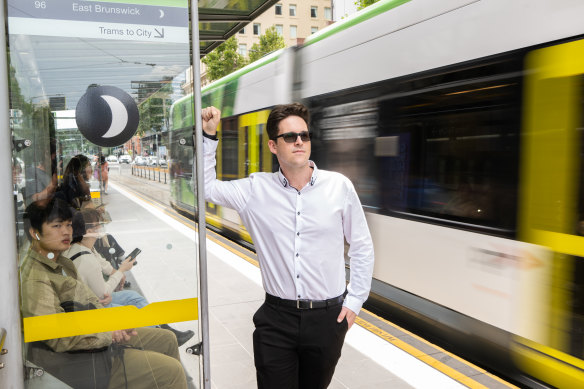
By contrast, South Melbourne offers a similar commute time, but has a higher median house price just north of $1.8 million and a median unit price of $620,000.
Extending the search just north of Coburg to Pascoe Vale could save money but at the cost of a longer commute. Pascoe Vale’s median house price is just under $800,000, but without a direct transport link to the university, commuting times would blow out by 10 to 20 minutes each way.
Neuzerling reproduced a version of the map showing commute times to Flinders Street Station for this masthead.
It shows a homebuyer commuting to the CBD could find similar commute times by train in either Coburg or Pascoe Vale, for example, but they would save money by purchasing in the latter.
Buyers’ advocate and Wakelin Property director Jarrod McCabe said he found a desire for direct transport links to be a common request from would-be home owners.
Loading
“There are clients that are more than happy to move a bit further out and be on a train line than to be in the same suburb and further away,” he said. “It is an important aspect. Not just for people getting into work but it’s also getting kids to school.
“It’s access to lifestyle, from a sports and arts point of view as well.”
McCabe said compromise was often necessary in the Melbourne property market, where houses have a median price of almost $1,033,000.
“Affordability is one of the biggest issues people face around property. We talk regularly with our clients about … finding the right location, the right level of improvements and the right price.
“For most people, the price is not flexible. One of the other two might have a bit of flexibility.”

Neuzerling said he had struggled to find the right type of home. Credit:Justin McManus
While his map revealed a surprising number of suburbs to choose from within their price range, Neuzerling found it difficult to find suitable housing.
“One thing I was a bit disappointed by was the lack of townhouses and medium density dwellings,” he said. “There are townhouses out there and there are townhouses being built.
Loading
“[But] not in the quantities I’d like.”
Grattan Institute economic program senior associate Joey Moloney said the lack of medium density homes in well-connected suburbs was a contributing factor in Melbourne’s housing affordability crisis.
“One of the failures of housing policy in Australia is it’s led to this increasing geographic inequality,” he said.
Moloney said this included easy access to services like healthcare and education aside from shorter commutes; the time spent driving and the costs associated with it were an economic drag on poorer families.
“The gap gets bigger and bigger when the geographical divide between the richer and poor grows.”
Moloney said a potential solution was a more purposeful, statewide planning process.
Monash professor in transport engineering Graham Currie said the issue was structural and was growing more entrenched.
“Australian cities have a tendency for lower income groups to live in affordable housing in the outer suburbs where public transport is poor,” he said. “This creates a problem where people relocate to the fringe for lifestyle and affordability reasons and they realise they need to have a car for every adult in the family.
“This ends up really squeezing their budgets and we get ‘forced car ownership’.
Neuzerling said better planning would make his property search that much easier.
“I was looking at planning decisions in the local council I live in,” he said. “It’s one of those places I can afford to rent but I won’t be able to buy.”



























